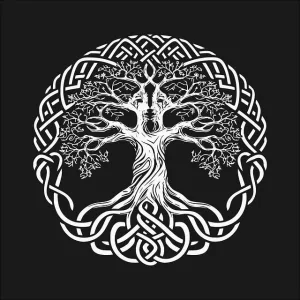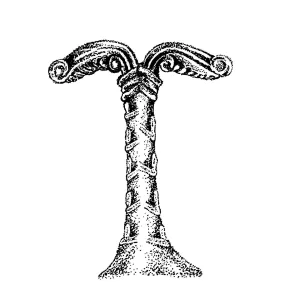Irminsul and Yggdrasil stand out as iconic representations of spiritual and cosmic frameworks. Both rooted in ancient Germanic and Norse traditions, they are often conflated or misunderstood. Let’s start from their origins and cultural context:
- Yggdrasil originates from Norse mythology, forming the centerpiece of the Eddaic cosmology. Known as the “World Tree,” it is described as a massive ash tree connecting the Nine Realms, from the heavens to the underworld. Its roots and branches span across existence, symbolizing the interconnectedness of life and the cosmos.
![Yggdrasil - world tree]()
Image by Quin Benson from Pixabay - Irminsul, on the other hand, is a sacred pillar or tree associated with the Saxons, a Germanic tribe. Its name translates to “great/mighty pillar” and symbolizes divine support or the axis mundi — linking heaven and earth. Unlike Yggdrasil, which is extensively documented in Norse texts, Irminsul is primarily known through historical records from external sources, such as accounts by Charlemagne and medieval chronicles.
![Irminsul, The Great Pillar]()
by Marianne Klement-Speckner
Difference #1: Symbolic Representations
Yggdrasil is explicitly a tree, often described in vivid detail in Norse texts. It serves as a habitat for mythical creatures, such as the dragon Níðhöggr, the squirrel Ratatoskr, and the eagles perched in its branches. Its roots draw from sacred wells, including the Well of Urd (fate), the Well of Mimir (wisdom), and the Hvergelmir (origin of rivers).
Irminsul, while sometimes associated with a tree, is more commonly depicted as a vertical pillar or structure. It embodies stability and a connection to the divine, often representing the Saxon people’s spiritual foundation. Archaeological evidence suggests that Irminsul could have been physical cult objects, unlike Yggdrasil’s conceptual framework.
Difference #2: Cosmological Function
Yggdrasil is the backbone of Norse cosmology. It connects the Nine Realms, including Asgard (home of the gods), Midgard (realm of humans), and Hel (underworld). It portrays the cyclic nature of existence, with constant threats of decay and rebirth through Ragnarok, the end of the world.
Irminsul serves a more regional and communal role. It symbolizes the unity of the Saxons and their link to divine authority. The destruction of Irminsul by Charlemagne in 772 CE was part of his campaign to Christianize the Saxons, highlighting its importance as a cultural and religious emblem.
Difference #3: Historical Sources
The Poetic Edda and Prose Edda, written by Snorri Sturluson, are primary sources for Yggdrasil’s mythology. These texts provide detailed narratives of the tree’s significance and its role in Norse cosmology.
Irminsul is documented primarily by external observers, such as the Frankish annals and the writings of Einhard, Charlemagne’s biographer. These sources describe Irminsul in the context of its destruction, emphasizing its role in Saxon paganism but offering limited insights into its spiritual symbolism.
Difference #4: Contemporary Legacy
In modern times, Yggdrasil has gained widespread recognition through literature, games, and art, often symbolizing ecological balance and the interconnectedness of life. It remains a powerful metaphor for spiritual and cosmic unity.

Irminsul, while less prominent, holds significance in the reconstruction of Germanic pagan traditions (Heathenry). It is celebrated as a symbol of resilience and cultural heritage, representing the enduring spirit of the Saxons.

Conclusion
While both Irminsul and Yggdrasil serve as axis mundi in their respective traditions, their roles, representations, and cultural contexts differ significantly. Yggdrasil’s expansive cosmological function contrasts with Irminsul’s regional and cultural symbolism. Together, they offer a glimpse into the rich spiritual and mythological traditions of the Germanic peoples, highlighting the diversity and depth of their worldviews.


